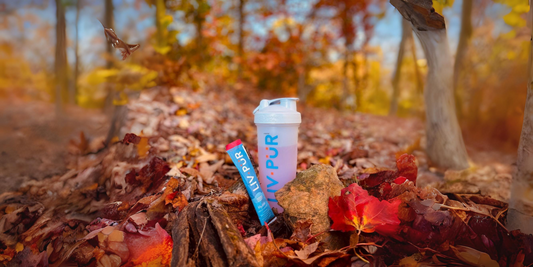The light is changing, the leaves are turning, and the night is growing.
We may want to slow down as temperatures begin to drop, but shorter days can put pressure on our schedules. Some even begin feeling the stress of the upcoming holiday season during this transitional period.
Are you ready for a reset? Here are seven healthy tips for moving mind and body into a new season.
1. Prepare for flu season.
Actually, the flu isn’t the only common sickness that picks up quickly come late September.
Colds, certain allergies, ear infections, and stomach viruses all peak during fall. Parents with school-age children are especially likely to see every seasonal bug from now until December.
Now is a prime time to see your doctor. Get a physical, update vaccinations, check in on any medications you’re taking, and screen for issues that could impact recovery in the future.
Also, thanks to flu season, scrubbing up at home is even more important than it is in the spring. Eliminate as much dust as you can, and consistently disinfect hard surfaces.
Finally, keep the hand washing skills you refined during COVID-19 extra sharp. You could reduce your chance of getting a cold or the flu by up to 21%.
2. Get outdoors just a little more.
Recent years have brought us the hottest summers on record, so lean into the crisp air of the fall season – it will benefit you in more ways than one.
First, the increase in physical activity will further fortify your body against flu and colds. It provides an immune boost and improves blood flow, which can help flush away germs that make us sick.
Taking brisk walks during the autumn months can also enhance your mental wellbeing. It can slow down the release of stress hormones and delay any seasonal mood shifts you experience during colder months.
Plus, it’s a good time to soak up as much sun-derived vitamin D as you can. As our sleeves get longer and layers get thicker, less of our skin is exposed to the sun. This is great for reducing the risk of sun damage and skin cancers, but it means you need a little bit more time to absorb a beneficial amount of sunshine.
3. Be mindful of hydration.
Speaking of those hot summers, how well did you hydrate? When it’s sweltering, you don’t need to be reminded to drink up.
Unfortunately, the same can’t be said for fall. Fluid loss is as much of a concern now as it was in July. From thicker clothing to the body’s internal efforts to shake off a chill, you’re losing more water than you probably realize.
So, stay on top of that water intake. And if you’re doing the right thing and ramping up physical activity, LivPur’s rapid rehydration solution offers amino acids and vitamins as well as electrolytes.
4. Explore the joy of seasonal eating.
If you want the freshest, most nutrient-dense foods to support better health, look no further than the fall harvest season.
In addition to higher-quality nutrition and environmental sustainability, you can support your community when you buy in-season foods locally.
Depending on your location, you might pick up the following:
- Apples
- Chard
- Potatoes
- Kale
- Celery
- Beets
- Pumpkins
- Squash
- Cauliflower
To find a farmers’ market near you, check out the USDA Local Food Directories.
5. Switch up your skincare.
As you bring your sweaters out of hiding, consider swapping your current personal care products for richer, more soothing formulas.
In many climates, humidity drops in the fall. Drier air not only leads to drier skin but may also exacerbate skin conditions.
Look into products containing hydrating ingredients such as hyaluronic acid, glycerin, or trehalose. Avoid stripping the skin with hot water and get a small humidifier to counteract the effects of indoor heating.
Finally, don’t assume that lower UV levels mean you can skimp on SPF. Continue using a sunscreen with a minimum SPF of 30 – many formulas available today include hydrating ingredients to help you address both concerns at once.
6. Get ahead of cabin fever.
The colder months can be more isolating, especially if your climate gets plenty of snow or you’re prone to conditions such as seasonal affective disorder. Taking extra care of your mental wellbeing today can mean a better mood tomorrow.
Make the most of fall activities right now and schedule some events for winter while you’re at it. Plan a holiday celebration or a trip to see loved ones. Having something to look forward to can curb some cold-weather dread.
Most importantly, plan out how you can enjoy time alone indoors. Put together a reading list, stock up on craft supplies, or make a watch list of TV shows and movies you’ve been meaning to watch.
7. Optimize your sleep schedule.
It happens every year, but shorter days and daylight savings can feel like jet lag. Autumn is a great time to revisit your sleep habits.
First, resist the urge to crank up the heat; cooler temps (about 68 degrees Fahrenheit) support higher-quality sleep.
If you’re trying to avoid disruptions from daylight savings, some experts recommend going to bed and waking up 15 minutes later than usual in the week leading up to the change.
Also, this is another good reason to stay on top of your exposure to natural light. Just 20 minutes of morning sun can help your body adjust to the season’s new rhythm.
Should you feel a little sluggish anyway, learn more about LivPur Energy. With natural caffeine, essential vitamins, and key additions like ashwagandha and magnesium, it’s a jitter-free, zero-sugar way to support mental clarity and endurance.
For a Healthy Fall and Beyond
Whether you’re excited for cooler weather or feel like slowing down, the fall season is all about preparing for the next phase. Fight the flu, stay active, and improve recovery with the above tips, and you can emerge rested, ready, and renewed this spring.




